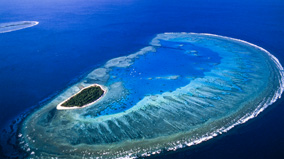Great Barrier Reef camping

Where you can camp
You can camp on several islands in the Great Barrier Reef. Most are national parks and part of the Great Barrier Reef World Heritage Area.
- Find camping locations and individual campground details, including access and facilities.
- Follow our responsible reef practices for visiting islands to ensure the environment and wildlife are not affected by your visit.
Note: Seasonal closures do apply to some islands and some activities are restricted or not allowed.
Book early
The number of campers allowed on some islands is limited so it is a good idea to book early. Camping bookings can open up to 12 months in advance to help you fit in with charter boat operators who have long lead times in yearly schedules. School holiday periods are often fully booked soon after bookings open.
Before you go camping you must get a camping permit to display on your tent—there are fines for camping without a permit.
You will need to make a booking and pay your camping fees to get a permit.
Protect the islands and reefs when you visit
The islands are fragile and easily damaged by careless visitors. They are also a refuge for marine wildlife.
- Camp in marked areas making sure you search for seabird or turtle nests before you set up camp or start an activity. If you find a nest, move your camp or do your activity elsewhere.
- Check the zoning information for restrictions on fishing and collecting shells. Spearfishing using scuba gear and collecting coral are prohibited.
- Anchor in sand or mud to avoid coral damage. Preferably use a lightweight reef pick with plastic tubing over the anchor chain to protect the coral.
- Protect the wildlife. Leave your pets at home.
- Never get too close to nesting seabirds. If disturbed, seabirds leave their nests and their chicks can die of exposure or be taken by predators.
- Stay on any walking tracks. You can injure yourself if you collapse a shearwater's nesting tunnel. You can also trap the baby bird. Please dig out the tunnel so the chick can escape.
- Be very careful using lights on beaches during turtle breeding season (November to March). Use only fuel stoves for cooking. Fires can attract and kill turtle hatchlings.
- If you go reef walking, disturb the animals as little as possible. Always replace any overturned rocks and don't touch any reef animals.
- Feed yourself, not the seagulls! Seagull numbers are increasing on many reef islands and threaten the survival of other birds.
- Use a fuel stove. Open fires are rarely allowed. Collect no firewood.
- Don't throw it, stow it. Dumping plastic and other rubbish at sea is illegal and can harm or even kill aquatic animals and seabirds. Take all your rubbish back to the mainland.
- If there are no toilets, bury human waste above the high tide level. Never bury rubbish.
Protect yourself when you visit
- Be self-sufficient. Few islands have water or facilities. Take everything you need. Allow at least five litres of water a day for each person in your group.
- Take extra supplies in case you get stranded by sudden changes in the weather.
- Be aware of tidal variations and strong currents. Anchor boats securely.
- Carry a marine band radio transceiver. Most sites are out of range for mobile phones.
- Be alert for sudden weather changes, particularly storms and cyclones. Be prepared to evacuate if necessary.
- Wear a hat and sunscreen.
More information
- Visit the Reef—how to plan for your visit to the Great Barrier Reef, activities and experiences you can enjoy in a responsible and Reef-friendly way, and reef conditions and zoning (where you can go and what you can do).